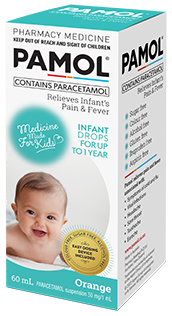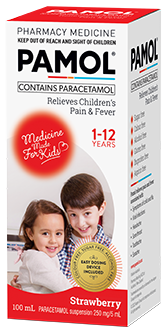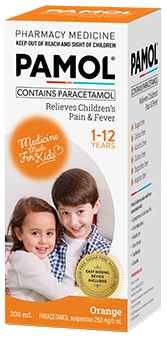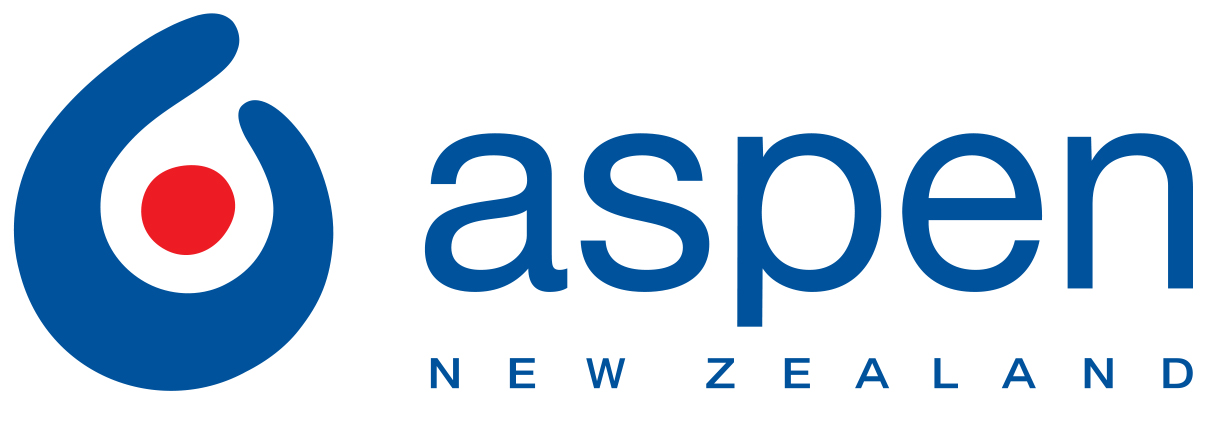Fever in Children and Tips to Help
Tips for fever
Fever is part of the body’s natural response to fight off infection. However, this can also leave your child feeling unwell and Pamol® may help to relieve your child’s fever. Please contact your doctor if your child is feeling ill or you are unsure about your child’s health.
What is a normal temperature?
A normal temperature is when your child’s body is around 37 degrees Celsius. A fever may be described as mild or high. A mild fever usually means between 38 and 39 degrees Celsius. A high fever usually means over 39 degrees Celsius. Remember that a child’s normal body temperature can vary depending on where it is measured, and also at different times of the day.
What is a fever?
A fever is a raised body temperature. When your child’s temperature is above 38 degrees Celsius ºC, it’s considered to be a fever. Fever by itself does not tell you whether your child is seriously sick.
When should I take my child’s temperature?
You should check your child’s temperature with a thermometer if they seem unwell, look overly flushed or feel hot to touch. See How to Take a Temperature.
What causes a fever?
The most common cause of fever is a viral infection, less commonly a bacterial infection. A fever is the body’s natural response to infection, as a rise in body temperature helps to kill the infection.
If you are worried about your child, whether or not there is a fever, you should take them to see a doctor.
Is it normal to have a fever while teething?
Some children can have a mild temperature when teething (although they will usually show other symptoms of teething too). If you are concerned about your child’s health, contact your healthcare professional.
Will a fever harm my baby?
Fever is a normal response to infection. Being hot may make your baby feel unhappy or uncomfortable. Pamol® may help to relieve the pain and discomfort associated with a fever and help to reduce a high fever. Always read the label and use as directed. Incorrect use can be harmful. If symptoms persist see your healthcare professional.
Please contact your doctor if your baby is under 3 months and has a fever or if you are unsure if your child is ill or unwell.
What should I do if my child has a fever?
- Reduce your child’s layers of clothing to just a single layer (eg. singlet and nappy/pants).
- Make sure the room is not too warm.
- Keep up fluids, and ensure your child rests.
- If your child is miserable because of the fever, then Pamol® may help to relieve the pain and discomfort associated with the fever.
- Use our handy Dose Calculator to work out the correct dose amount.
- Give Pamol® every four hours if required (not sooner), and with no more than four doses within a 24-hour period.
- Do not exceed the dose recommendations. Always read the label and use as directed. Incorrect use can be harmful. If symptoms persist see your healthcare professional.
What should I do if my baby has a fever?
Young babies less than three months old are not very good yet at controlling their own body temperature. Wrapping a baby in too many layers can cause him or her to overheat. If your baby is unwell, and has a temperature, you should contact your healthcare professional.
When should I take my child to the doctor?
A fever by itself does not mean your child is very sick. However look for other signs and symptoms and if you are concerned about your child’s health contact your healthcare professional.

How to take children’s temperature:
It’s a good idea to check your child’s temperature if they feel hot, and they seem unwell. You should measure temperature in places that are closest to the body’s core temperature such as inside the mouth (oral), under the arm (axillary), in the outer ear canal (tympanic), and on the forehead.
Types of thermometers:
There are a range of thermometers available to measure the temperature of your little ones. Most are available in pharmacy – ask your pharmacist to show you the different types and how to use them when you are considering which is best for your family.
Digital thermometers: |
Ear thermometers: |
Forehead thermometers: |
|---|---|---|
| Can be used orally (in the mouth), or axillary (under the arm). These thermometers are easy to use with a short measurement time, and a simple digital readout.
Most will beep when the measurement is finished, and is ready to read. |
Very quick and easy to read. Simply insert the tip in your child’s ear, and press the button.The thermometer will beep when the measurement is finished and is ready to read. |
These are a new style of thermometer.
Simply hold it against your child’s forehead and press the button. Very simple and easy to use. |
For more information, check out www.kidshealth.org.nz/how-take-temperature
If you are unsure about your child’s health:
- Visit www.kidshealth.org.nz for more information and helpful guides.
- Talk to your Plunket nurse or call Plunketline for helpful parenting and Well Child advice.
- Contact Healthline for medical advice. Or if it’s an an emergency, call 111.





